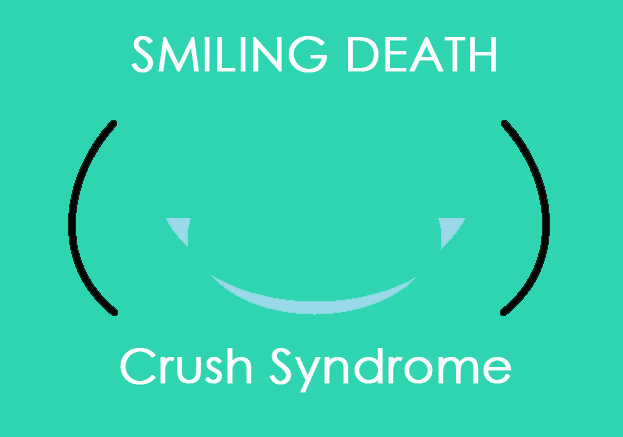This condition seen people who are trapped under a heavy object or rubbles for hours. They may suffering from the crush syndrome. Rescuers often do not realize that the patient needs treatment before rescue. Without proper preparation, the patient, with pain control, may be cheerful before extrication, but die shortly thereafter. This sudden decompensation is called the "smiling death." It can be expected any event where patients are trapped under a crushing weight more than 4 hours.
Heavy weight on body parts may partially or completely cut off blood flow. Decrease in oxygen supply leads to anaerobic metabolism, skeletal muscle tissue begins to break down. As muscle cells die, they absorb sodium, water and calcium; releases potassium, myoglobin, phosphate and other toxins. When a patient is released from weight, blood flow is returned and these chemicals circulate throughout the body. Resulting in shock, acute renal failure, cardiac arrest and other systemic symptoms.
- When you lose weight, where does the fat actually go?
- Capsula mundi: these burial pods will turn your loved ones into trees
Cases occur commonly in catastrophes such as earthquakes, to victims that have been trapped under fallen or moving masonry. Treatment involves considerable difficulties because we must deal with a large number of patients at the time of a disaster.
Extra Juice:
Heavy weight on body parts may partially or completely cut off blood flow. Decrease in oxygen supply leads to anaerobic metabolism, skeletal muscle tissue begins to break down. As muscle cells die, they absorb sodium, water and calcium; releases potassium, myoglobin, phosphate and other toxins. When a patient is released from weight, blood flow is returned and these chemicals circulate throughout the body. Resulting in shock, acute renal failure, cardiac arrest and other systemic symptoms.
- When you lose weight, where does the fat actually go?
- Capsula mundi: these burial pods will turn your loved ones into trees
Cases occur commonly in catastrophes such as earthquakes, to victims that have been trapped under fallen or moving masonry. Treatment involves considerable difficulties because we must deal with a large number of patients at the time of a disaster.
Extra Juice:
- Seigo Minami, a Japanese physician, first reported the crush syndrome in 1923. He studied the pathology of three soldiers who died in World War I from insufficiency of the kidney. The renal changes were due to methohemoglobin infarction, resulting from the destruction of muscles.
- Due to the risk of crush syndrome, current recommendation to lay first-aiders (in the UK) is to not release victims of crush injury who have been trapped for more than 15 minutes.



Comments
Post a Comment